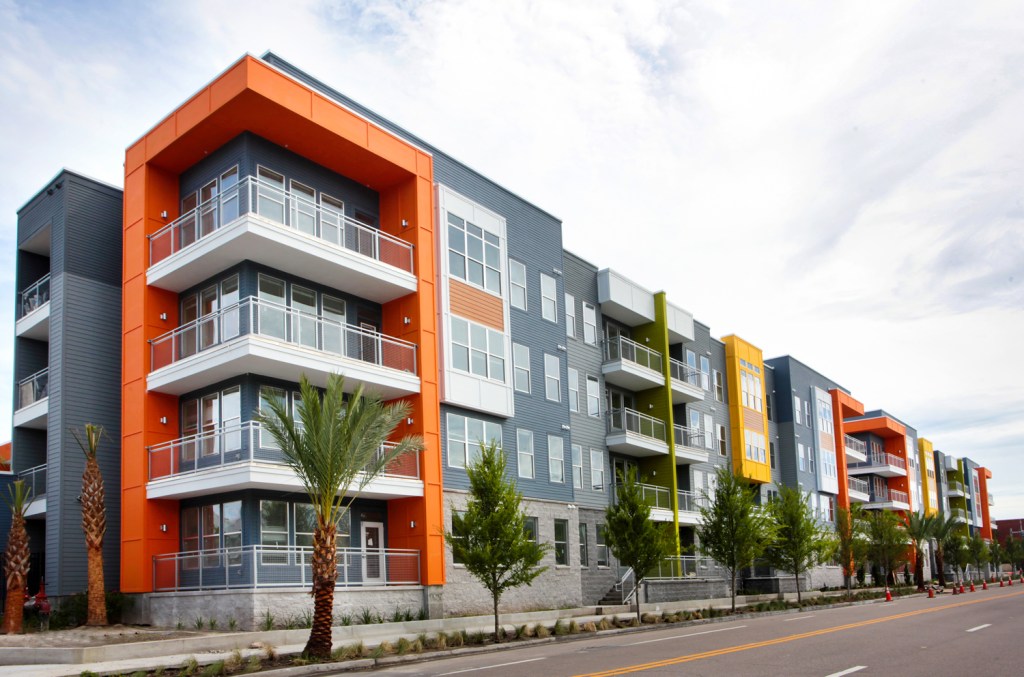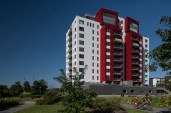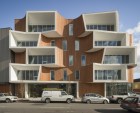Jacksonville, Fla., isn’t the first place that comes to mind when you consider edgy urban chic. Yet the once-sleepy Brooklyn neighborhood of this northern Florida coastal metropolis is undergoing a stirring Miami South Beach-flavored renaissance, led by a $40 million apartment community called the Brooklyn Riverside.
The 310-unit Brooklyn Riverside, which was delivered in April 2015, is marked by bold festive colors and jaunty cantilevers. It’s a design bet that is an “absolute home run” for the developer and the community.
Powered by Wood
“We kept the base of the building fairly simple,” observes the project’s lead architect, Jason Shephard, AIA, and principal of Dwell Design Studio, an award-winning national design firm specializing in multifamily projects.
“We wanted to use pops of color to accentuate the large overhangs and some of the vertical bends to break up the overall mass of the building,” Shephard says. “People comment all the time, ‘This isn’t wood frame.’ I tell them it’s all wood frame, a type V structure. There’s hardly any steel at all. It’s all done with wood trusses and how we creatively framed the building to pick up those overhangs. It’s very unexpected.
Cost Savings
Wood is cost-effective and was central to the project development. Besides the near-absence of steel, the use of concrete was minimized too. There is no podium base. Parking is allocated to 77 private tuck-under garages and 373 surface spaces.
Shephard says his design ethos was shaped in part by the downturn. “Nobody could afford structured parking,” the designer states. So Dwell Design has focused on a multifamily design concept called “ditch the deck.” The idea: Rely solely on wood to drive design and development economics. “No concrete podium is huge from a cost perspective.”
Code & Climate
Brooklyn Riverside even had code officials cheering. “They preferred it from a building code standpoint. We observed expected fire resistive practices, including a full sprinkler system and other code-compliant safeguards. We didn’t have to increase our fire rating from a floor-ceiling standpoint, for example,” Shephard says.
Building codes require all structures to perform to the same level of safety, regardless of material used, and wood-frame buildings can be designed to meet or exceed standards for fire protection and resistance to harsh weather. In the case of Brooklyn Riverside, code required a one-hour fire rating, typical of multifamily properties. Wood construction fully complies with that rating standard.
And Jacksonville’s humid coastal climate? “We carefully considered wind-blown rain. We went with a zip-wall system. It’s an engineered sheathing with a built-in vapor and air barrier. There’s a bit of a cost bump, but it’s minor. It’s definitely worth it for this region.”
39 Units/Acre
The bold aesthetic has earned its share of rave reviews. But Shephard points to the project economics with equal pride. For example, Brooklyn Riverside is nearly leased-up, with occupancy at about 97 percent. “They’ve been killing it” as Shephard says of the leasing pace.
With cost of land rising, developers want value-engineered solutions that deliver more density, surface parking, and wood-frame performance capabilities. Brooklyn Riverside works from all perspectives—design, development, and community.
“It’s an absolute home run.”



